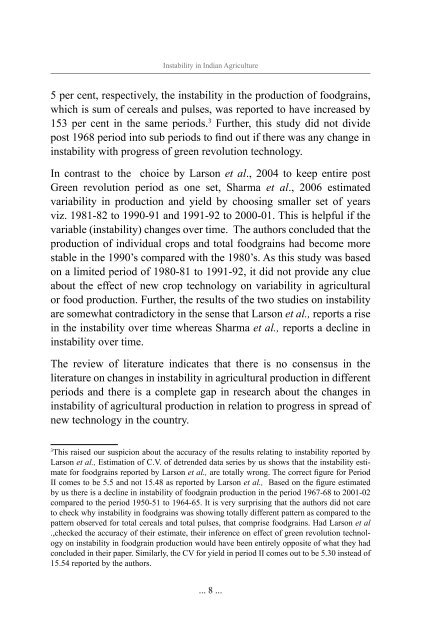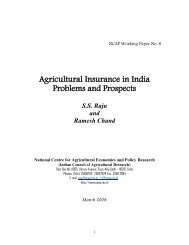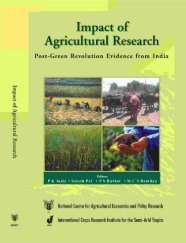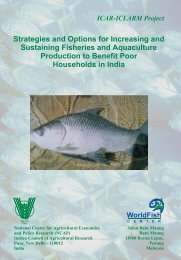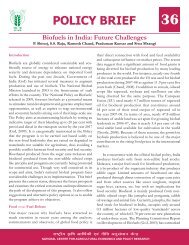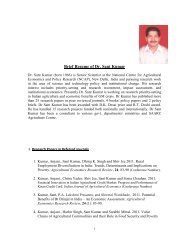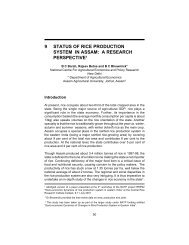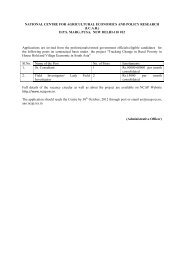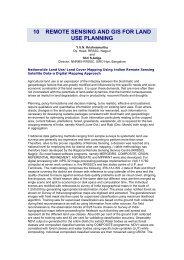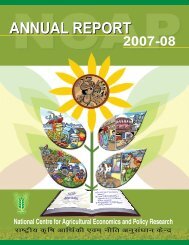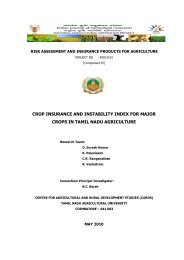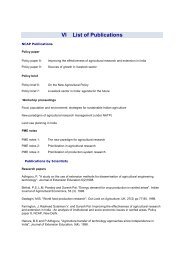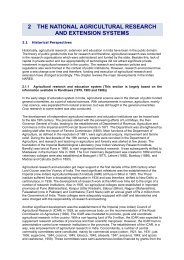Instability in Indian Agriculture - NCAP
Instability in Indian Agriculture - NCAP
Instability in Indian Agriculture - NCAP
You also want an ePaper? Increase the reach of your titles
YUMPU automatically turns print PDFs into web optimized ePapers that Google loves.
<strong>Instability</strong> <strong>in</strong> <strong>Indian</strong> <strong>Agriculture</strong><br />
5 per cent, respectively, the <strong>in</strong>stability <strong>in</strong> the production of foodgra<strong>in</strong>s,<br />
which is sum of cereals and pulses, was reported to have <strong>in</strong>creased by<br />
153 per cent <strong>in</strong> the same periods. 3 Further, this study did not divide<br />
post 1968 period <strong>in</strong>to sub periods to f<strong>in</strong>d out if there was any change <strong>in</strong><br />
<strong>in</strong>stability with progress of green revolution technology.<br />
In contrast to the choice by Larson et al., 2004 to keep entire post<br />
Green revolution period as one set, Sharma et al., 2006 estimated<br />
variability <strong>in</strong> production and yield by choos<strong>in</strong>g smaller set of years<br />
viz. 1981-82 to 1990-91 and 1991-92 to 2000-01. This is helpful if the<br />
variable (<strong>in</strong>stability) changes over time. The authors concluded that the<br />
production of <strong>in</strong>dividual crops and total foodgra<strong>in</strong>s had become more<br />
stable <strong>in</strong> the 1990’s compared with the 1980’s. As this study was based<br />
on a limited period of 1980-81 to 1991-92, it did not provide any clue<br />
about the effect of new crop technology on variability <strong>in</strong> agricultural<br />
or food production. Further, the results of the two studies on <strong>in</strong>stability<br />
are somewhat contradictory <strong>in</strong> the sense that Larson et al., reports a rise<br />
<strong>in</strong> the <strong>in</strong>stability over time whereas Sharma et al., reports a decl<strong>in</strong>e <strong>in</strong><br />
<strong>in</strong>stability over time.<br />
The review of literature <strong>in</strong>dicates that there is no consensus <strong>in</strong> the<br />
literature on changes <strong>in</strong> <strong>in</strong>stability <strong>in</strong> agricultural production <strong>in</strong> different<br />
periods and there is a complete gap <strong>in</strong> research about the changes <strong>in</strong><br />
<strong>in</strong>stability of agricultural production <strong>in</strong> relation to progress <strong>in</strong> spread of<br />
new technology <strong>in</strong> the country.<br />
3<br />
This raised our suspicion about the accuracy of the results relat<strong>in</strong>g to <strong>in</strong>stability reported by<br />
Larson et al., Estimation of C.V. of detrended data series by us shows that the <strong>in</strong>stability estimate<br />
for foodgra<strong>in</strong>s reported by Larson et al., are totally wrong. The correct figure for Period<br />
II comes to be 5.5 and not 15.48 as reported by Larson et al., Based on the figure estimated<br />
by us there is a decl<strong>in</strong>e <strong>in</strong> <strong>in</strong>stability of foodgra<strong>in</strong> production <strong>in</strong> the period 1967-68 to 2001-02<br />
compared to the period 1950-51 to 1964-65. It is very surpris<strong>in</strong>g that the authors did not care<br />
to check why <strong>in</strong>stability <strong>in</strong> foodgra<strong>in</strong>s was show<strong>in</strong>g totally different pattern as compared to the<br />
pattern observed for total cereals and total pulses, that comprise foodgra<strong>in</strong>s. Had Larson et al<br />
.,checked the accuracy of their estimate, their <strong>in</strong>ference on effect of green revolution technology<br />
on <strong>in</strong>stability <strong>in</strong> foodgra<strong>in</strong> production would have been entirely opposite of what they had<br />
concluded <strong>in</strong> their paper. Similarly, the CV for yield <strong>in</strong> period II comes out to be 5.30 <strong>in</strong>stead of<br />
15.54 reported by the authors.<br />
... 8 ...


